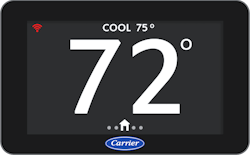Improving HVAC Efficiency with Machine Learning
Improving HVAC Efficiency with Machine Learning
Achieving building automation system (BAS) benefits often presents unique technical and financial challenges for small‑ to medium‑sized buildings. These can include:
• HVAC system designs that do not justify the investment required for a BAS
• Customers that may not want or need additional BAS features
• Up‑front costs and multi‑year payback scenarios can be a deterrent
• System complexity may drive the need for full‑time management
Such was the case recently facing management at the Brea, California sales office of Russell Sigler, Inc. For over 50 years,Sigler wanted to improve the performance of its rooftop units (RTUs), increase employee’s comfort, lower energy usage and also achieve an innovative level of HVAC "system" management. Additionally, compliance with Title 24—California’s energy code designed to reduce wasteful and unnecessary energy consumption in newly constructed and existing buildings—was a significant contributing factor.
To begin the process, Sigler drew from their expertise and selected Carrier® Connect™ Wi‑Fi® commercial thermostats to replace their existing ones. The Connect thermostat’s many features include:
• Intuitive 2.8-in. touchscreen interface
• Smartphone mobile app (iPhone and Android) and web portal
• Title 24 compliance
• Energy use monitoring
• Ease of installation, set‑up and usage.
Once the new Connect thermostats were installed, Sigler Brea wanted to further enhance their functionality, monitoring and real‑time management. To accomplish this, they would synchronize Sigler’s RTUs, transforming them into smart, networked, energy‑responsive assets. “Sigler Brea had 13 rooftop units with individually connected thermostats, and wanted to have the enhanced control and energy management benefits of a traditional BAS, but without the associated complexity and at 10‑20%Now, at Sigler Brea, the successful integration of the Carrier Connect thermostats with Swarm Logic® Virtual BAS technology has created a solution which dramatically improved their building’s operational—and subsequently—energy efficiency, by executing the following protocol:
• Carrier Connect thermostats collect data from Sigler Brea’s RTUs every few minutes
• This collected data is then sent to Swarm Logic via the cloud
• This interpreted data defines decisions to optimize each RTU’s operations and returns the decision to Sigler Brea’s Connect thermostat
• The Connect thermostats then adjust the RTUs in accordance with pre‑set comfort and energy usage parameters within Sigler Brea’s office space
“We were excited to maximize our facility’s RTU’s efficiency by extending the full operational capabilities of the Carrier Connect thermostats with an energy management system,” said Anthony Bermudez, Area Controls Sales Manager of Russell Sigler, Inc. “The dashboard is intuitive, easy to use and provides us with a wide range of management tools and important operating data.” he continued.
As a result, Sigler Brea has realized up to 20% reductions in HVAC kW, kWh, and CO2, which helps improve their bottom line. “Access to the portal is easy and secure,” commented Anthony Cerrato, Controls Sales Manager of Sigler Brea. “Our authorized personnel log in on a weekly basis to review summarized trending issues such as energy savings, demand response and RTU performance issues. Right after the initial integration of our Connect thermostats, we were able to identify RTUs which were running when they shouldn’t have been and re‑configured them immediately,” he concluded.


